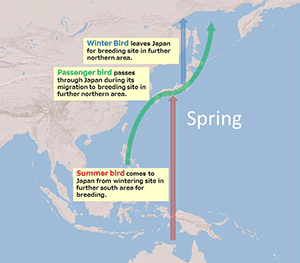 |
 |
 |
 |
 |
A .
Many waterbirds living in wetlands (e.g. duck, snipe) migrate in spring and autumn. Most of the ducks and swans coming to Japan in winter spend the summer in northern countries such as Russia and China. There are also birds which go back and forth between those northern countries and countries south of Japan. Many of those birds pass through the Japan archipelago, taking a rest in tidal flats and on the seacoast during their journey. Migratory birds travel without caring about borderlines decided by human beings.
If we secure dwelling places for those waterbirds, we will have to secure all places which they visit for migration. This means it is necessary to conserve all wetlands where they stay for breeding, wintering, and resting. In order to conserve all those wetlands which are located in various countries, we need to cooperate with many countries and act together. There is an agreement which is made up among many countries all over the world in order to protect wetlands in union under a rule. This is the Ramsar Convention.
The Ramsar Convention is a rule to protect wetlands where waterbirds live, not waterbirds themselves. However, by protecting whole wetlands we can protect not only waterbirds but also other animals and plants.
Waterfowl food varies greatly according to their species. Some eat fish and shellfish which live in wetlands. Others eat plants which grow on the waterfront or in the water, plankton, and dead animals. The protection of waterfowls means: 1) protecting living things that are waterfowl food, 2) protecting the habitats of such wildlife, and 3) protecting our living environment.
|
|
 |
 |
 |
 |
|

We, Latham's snipes,
make a long trip
from Japan to Australia.
|


 Bird Migration in Japan (Spring)
Bird Migration in Japan (Spring)

 Bird Migration in Japan (Autumn)
Bird Migration in Japan (Autumn)





 Bird Migration in Japan (Spring)
Bird Migration in Japan (Spring)

 Bird Migration in Japan (Autumn)
Bird Migration in Japan (Autumn)


